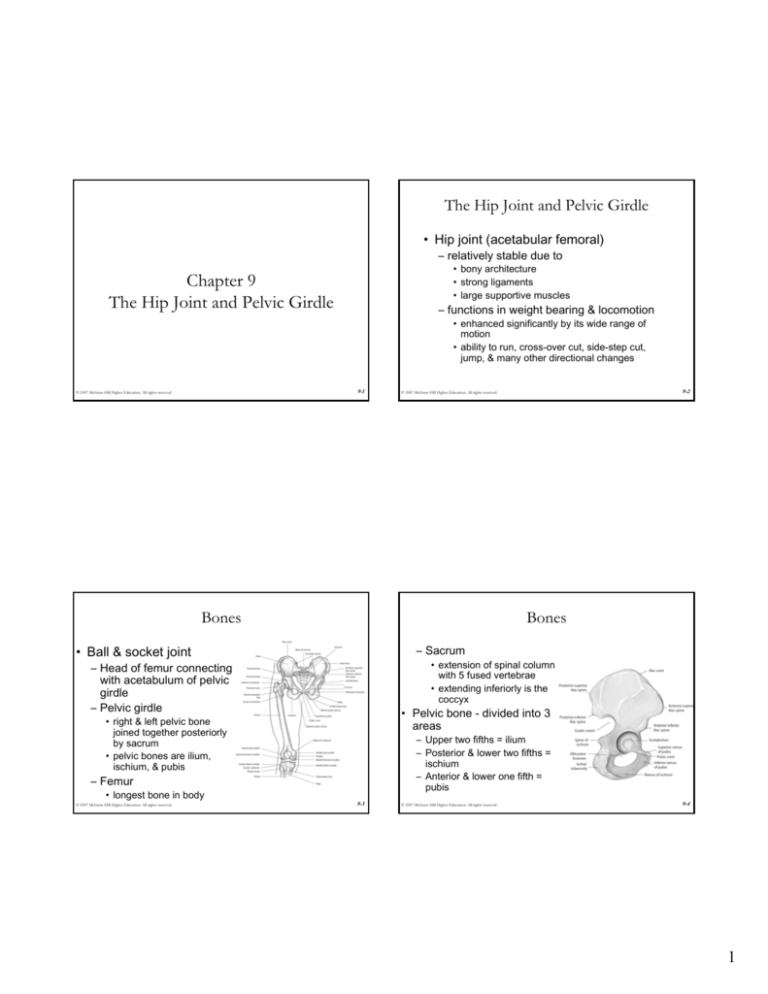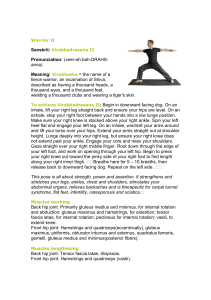
The Hip Joint and Pelvic Girdle
• Hip joint (acetabular femoral)
– relatively stable due to
• bony architecture
• strong ligaments
• large supportive muscles
Chapter 9
The Hip Joint and Pelvic Girdle
– functions in weight bearing & locomotion
• enhanced significantly by its wide range of
motion
• ability to run, cross-over cut, side-step cut,
jump, & many other directional changes
9-1
© 2007 McGraw-Hill Higher Education. All rights reserved.
Bones
Bones
• Ball & socket joint
– Sacrum
• extension of spinal column
with 5 fused vertebrae
• extending inferiorly is the
coccyx
– Head of femur connecting
with acetabulum of pelvic
girdle
– Pelvic girdle
• Pelvic bone - divided into 3
areas
• right & left pelvic bone
joined together posteriorly
by sacrum
• pelvic bones are ilium,
ischium, & pubis
– Upper two fifths = ilium
– Posterior & lower two fifths =
ischium
– Anterior & lower one fifth =
pubis
– Femur
• longest bone in body
© 2007 McGraw-Hill Higher Education. All rights reserved.
9-2
© 2007 McGraw-Hill Higher Education. All rights reserved.
9-3
© 2007 McGraw-Hill Higher Education. All rights reserved.
9-4
1
Bones
Bones
• Bony landmarks
• Bony landmarks
– Anterior pelvis - origin
for hip flexors
– Lateral pelvis origin for hip
abductors
• tensor fasciae latae anterior iliac crest
• sartorius - anterior
superior iliac spine
• rectus femoris anterior inferior iliac
spine
• gluteus medius &
minimus - just
below iliac crest
9-5
© 2007 McGraw-Hill Higher Education. All rights reserved.
Bones
Bones
• Bony landmarks
• Bony landmarks
– Medially - origin for
hip adductors
– Posteriorly – origin for hip
extensors
• adductor magnus,
adductor longus,
adductor brevis,
pectineus, & gracilis pubis & its inferior
ramus
© 2007 McGraw-Hill Higher Education. All rights reserved.
9-6
© 2007 McGraw-Hill Higher Education. All rights reserved.
• gluteus maximus posterior iliac crest &
posterior sacrum & coccyx
– Posteroinferiorly - origin
for hip extensors
• hamstrings - ischial
tuberosity
9-7
© 2007 McGraw-Hill Higher Education. All rights reserved.
9-8
2
Bones
Bones
• Bony landmarks
• Bony landmarks
– Proximal thigh - insertion for short
muscles of hip
– Patella – insertion for all 4
quadriceps muscles
– Proximal tibia or fibula – insertion
for remainder of hip muscles
• gluteal muscles & most of the six
deep external rotators - greater
trochanter
• iliopsoas - lesser trochanter
• sartorius, gracilis, & semitendinosus
- upper anteromedial tibial surface
just below medial condyle after
crossing knee posteromedially
• semimembranosus - posteromedially
on medial tibial condyle
– Proximal thigh - origin for 3 knee
extensors
• three vasti muscles of quadriceps –
anteriorly
• hip adductors - linea aspera
9-9
© 2007 McGraw-Hill Higher Education. All rights reserved.
Bones
Joints
• Anteriorly
• Bony landmarks
– Two pelvic bones join to form
symphysis pubis,
amphiarthrodial
– Proximal tibia or fibula – insertion
for remainder of hip muscles
• biceps femoris – laterally, primarily
on fibula head with some fibers
attaching on lateral tibial condyle
• iliotibial tract of tensor fasciae latae –
anterolaterally on Gerdy’s tubercle of
tibia
© 2007 McGraw-Hill Higher Education. All rights reserved.
9-10
© 2007 McGraw-Hill Higher Education. All rights reserved.
• Posteriorly
– Sacrum is between the 2 pelvic
bones & forms the sacroiliac
joints
– Strong ligaments unite these
bones to form rigid, slightly
movable joints
9-11
© 2007 McGraw-Hill Higher Education. All rights reserved.
9-12
3
Joints
Joints
• Large & heavy bones covered by thick,
heavy muscles
• Very minimal oscillating-type movements
occur in sacroiliac joints, as in walking
• Body movements usually involve entire
pelvic girdle & hip joints
• In walking, hip flexion & extension occur
with pelvic girdle rotation, forward in hip
flexion & backward in hip extension
• Jogging & running result in faster
movements & greater range of
movement
• Pelvic rotation increases the length of
stride in running; in kicking it results in a
greater distance or more speed to the
kick
9-13
© 2007 McGraw-Hill Higher Education. All rights reserved.
Joints
Joints
• Acetabulofemoral joint - most mobile
joints of body (except glenohumeral)
• Acetabulofemoral joint
– Iliofemoral or Y
ligament – located
anteriorly, prevents
hyperextension
– Pubofemoral ligament located anteromedially
& inferiorly, limits
excessive extension &
abduction
– Multiaxial arrangement
– Bony architecture provides stability
• relatively few hip joint subluxations &
dislocations
– Enarthrodial-type joint
– Femoral head inserting into acetabulum
– Reinforced by extremely strong & dense
ligamentous capsule, especially anteriorly
© 2007 McGraw-Hill Higher Education. All rights reserved.
9-14
© 2007 McGraw-Hill Higher Education. All rights reserved.
9-15
© 2007 McGraw-Hill Higher Education. All rights reserved.
9-16
4
Joints
Joints
• Acetabulofemoral joint
• Some disagreement
about exact possible
range of each
movement in hip joint
– Teres ligament - attaches
from deep in acetabulum to a
depression in femoral head,
slightly limits adduction
– Ischiofemoral ligament –
located posteriorly, extends
from ischium to trochanteric
fossa of femur, limits internal
rotation
– 0 to 130 degrees of
flexion
– 0 to 30 degrees of
extension
9-17
© 2007 McGraw-Hill Higher Education. All rights reserved.
Joints
Joints
– 0 to 35 degrees of abduction
– 0 to 30 degrees of adduction
© 2007 McGraw-Hill Higher Education. All rights reserved.
9-18
© 2007 McGraw-Hill Higher Education. All rights reserved.
– 0 to 45 degrees of internal rotation
– 0 to 50 degrees of external rotation
9-19
© 2007 McGraw-Hill Higher Education. All rights reserved.
9-20
5
Joints
Joints
Motions accompanying pelvic rotation
• Pelvic girdle moves back & forth within
3 planes for a total of 6 different
movements
– All pelvic girdle rotation results from motion
at one or more locations
• right hip
• left hip
• lumbar spine
Lumbar Spine
Motion
Left Hip
Motion
Anterior rotation
Extension
Flexion
Flexion
Flexion
Extension
Extension
Right lateral
rotation
Right lateral
flexion
Adduction
Abduction
Abduction
Adduction
Right transverse
rotation
Left transverse
rotation
Internal
rotation
External
rotation
Left transverse
rotation
Right transverse
rotation
External
rotation
Internal
rotation
9-22
© 2007 McGraw-Hill Higher Education. All rights reserved.
Movements
Movements
• Hip flexion
• Anterior & posterior pelvic rotation
– movement of femur
straight anteriorly toward
pelvis
– sagittal or anteroposterior plane
• Right & left lateral rotation
– lateral or frontal plane
• Hip extension
• Right transverse (clockwise) rotation &
left transverse (counterclockwise)
rotation
– movement of the femur
straight posteriorly away
from the pelvis;
sometimes referred to as
hyperextension
– horizontal or transverse plane of motion
© 2007 McGraw-Hill Higher Education. All rights reserved.
Right Hip
Motion
Posterior rotation
Left lateral rotation Left lateral flexion
9-21
© 2007 McGraw-Hill Higher Education. All rights reserved.
Pelvic Rotation
9-23
© 2007 McGraw-Hill Higher Education. All rights reserved.
9-24
6
Movements
Movements
• Hip external rotation
• Hip abduction
– rotary movement of femur
laterally around its
longitudinal axis away from
midline; lateral rotation
– movement of femur
laterally to side away from
midline
• Hip adduction
• Hip internal rotation
– movement of femur
medially toward midline
– rotary movement of femur
medially around its
longitudinal axis toward to
midline; medial rotation
9-25
© 2007 McGraw-Hill Higher Education. All rights reserved.
Movements
Movements
• Hip diagonal abduction
• Anterior pelvic rotation
– movement of femur in a
diagonal plane away from
midline of body
– anterior movement of upper
pelvis; iliac crest tilts forward in
a sagittal plane; anterior tilt
• Hip diagonal adduction
• Posterior pelvic rotation
– movement of femur in a
diagonal plane toward
midline of body
© 2007 McGraw-Hill Higher Education. All rights reserved.
9-26
© 2007 McGraw-Hill Higher Education. All rights reserved.
– posterior movement of upper
pelvis; iliac crest tilts backward
in a sagittal plane; posterior tilt
9-27
© 2007 McGraw-Hill Higher Education. All rights reserved.
9-28
7
Movements
Movements
• Left transverse pelvic rotation
• Left lateral pelvic rotation
– in frontal plane left pelvis moves inferiorly
in relation to right pelvis; either left pelvis
rotates downward or right pelvis rotates
upward; left lateral tilt
– in horizontal plane pelvis rotates to
body's left; right iliac crest moves
anteriorly in relation to left iliac
crest, which moves posteriorly
• Right lateral pelvic rotation
• Right transverse pelvic rotation
– in frontal plane right pelvis moves inferiorly
in relation to left pelvis; either right pelvis
rotates downward or left pelvis rotates
upward; right lateral tilt
– in horizontal plane pelvis rotates to
body's right; left iliac crest moves
anteriorly in relation to right iliac
crest, which moves posteriorly
9-29
© 2007 McGraw-Hill Higher Education. All rights reserved.
9-30
© 2007 McGraw-Hill Higher Education. All rights reserved.
Muscles
Muscles
• Seven two-joint muscles have one action
at hip & another at knee
• Muscles involved in hip & pelvic girdle
motions depend largely on direction of
movement and position of body in relation to
earth & gravitational forces
• Body part that moves most will be the part
least stabilized
– Standing on both feet & contracting hip flexors, the
trunk & pelvis rotate anteriorly
– Lying supine & contracting hip flexors, the thighs
move forward into flexion on the stable pelvis
© 2007 McGraw-Hill Higher Education. All rights reserved.
Modified from Anthony CP, Kolthoff NJ: Textbook of
anatomy and physiology, ed 9, St. Louis, 1975, Mosby.
9-31
© 2007 McGraw-Hill Higher Education. All rights reserved.
9-32
8
Muscles
Muscles
• Hip flexor muscles used in moving thighs up
toward trunk
• Hip extensor muscles used eccentrically
when pelvis & trunk move downward slowly
on the femur and concentrically when trunk is
raised on femur (rising to standing position)
• In downward phase of knee-bend exercise,
movement at hips & knees is flexion
• Hip joint & pelvic girdle
muscles
– Anterior - primarily hip
flexion
•
•
•
•
Iliopsoas
Pectineus
Rectus femoris
Sartorius
– muscles primarily involved - hip & knee extensors
in eccentric contraction
9-33
© 2007 McGraw-Hill Higher Education. All rights reserved.
Muscles
Muscles
– Medial - primarily hip
adduction
•
•
•
•
– Posterior - primarily hip
extension
Adductor brevis
Adductor longus
Adductor magnus
Gracilis
© 2007 McGraw-Hill Higher Education. All rights reserved.
9-34
© 2007 McGraw-Hill Higher Education. All rights reserved.
•
•
•
•
•
9-35
Gluteus maximus
Biceps femoris
Semitendinosus
Semimembranosus
External rotators
© 2007 McGraw-Hill Higher Education. All rights reserved.
9-36
9
Muscles
Muscles
• Pelvic muscles acting on hip joint
– Lateral - primarily hip
abduction
•
•
•
•
– Iliac region - iliopsoas muscle flexes hip
• Iliacus
• Psoas major
• Psoas minor
Gluteus medius
Gluteus minimus
External rotators
Tensor fasciae latae
9-37
© 2007 McGraw-Hill Higher Education. All rights reserved.
Muscles
Muscles
• Pelvic muscles acting on hip joint
• Thigh - divided into 3 compartments by
intermuscular septa
– Gluteal region - extend & rotate hip
•
•
•
•
•
9-38
© 2007 McGraw-Hill Higher Education. All rights reserved.
Gluteus maximus
Gluteus medius
Gluteus minimi
Tensor fascia latae
Six deep external rotators - piriformis, obturator
externus, obturator internus, gemellus superior,
gemellus inferior, & quadratus femoris
© 2007 McGraw-Hill Higher Education. All rights reserved.
9-39
© 2007 McGraw-Hill Higher Education. All rights reserved.
9-40
10
Muscles
Muscles
– Anterior compartment – primarily knee
extensors
•
•
•
•
•
– Medial compartment - primarily adductors
•
•
•
•
•
Rectus femoris
Vastus medialis
Vastus intermedius
Vastus lateralis
Sartorius
Adductor brevis
Adductor longus
Adductor magnus
Pectineus
Gracilis
– Posterior compartment - hamstring group
• Biceps femoris
• Semitendinosus
• Semimembranosus
9-41
© 2007 McGraw-Hill Higher Education. All rights reserved.
Nerves
Nerves
• All hip & pelvic girdle muscles innervated from lumbar & sacral plexus
(lumbosacral plexus)
© 2007 McGraw-Hill Higher Education. All rights reserved.
9-42
© 2007 McGraw-Hill Higher Education. All rights reserved.
– Lumbar plexus formed by anterior
rami of spinal nerves
L1 through L4 & some
fibers from T12
• Lower abdomen
and the anterior &
medial portions of
lower extremity
9-43
© 2007 McGraw-Hill Higher Education. All rights reserved.
9-44
11
Nerves
Nerves
• Lumbar plexus - major nerves
– Femoral n. - anterior muscles
– Sacral plexus - formed
by anterior rami of L4,
L5, & S1 through S4
• Lower back, pelvis,
perineum, posterior
surface of thigh &
leg, and dorsal &
plantar surfaces of
foot
9-45
© 2007 McGraw-Hill Higher Education. All rights reserved.
• Arises from posterior division of
lumbar plexus
• Iliopsoas
• Rectus femoris
• Vastus medialis
• Vastus intermedius
• Vastus lateralis
• Pectineus
• Sartorius
• Sensation to anterior & lateral
thigh and medial leg & foot
© 2007 McGraw-Hill Higher Education. All rights reserved.
Nerves
Nerves
• Lumbar plexus - major nerves
• Sacral plexus
– Obturator nerve
– Superior gluteal nerve
• Arises from anterior division of
lumbar plexus
• Adductor brevis
• Adductor longus
• Adductor magnus
• Gracilis
• Obturator externus
• Sensation to medial thigh
© 2007 McGraw-Hill Higher Education. All rights reserved.
9-46
• arises from L4, L5, & S1 to innervate gluteus
medius, gluteus minimus, & tensor fasciae
latae
– Inferior gluteal nerve
• arises from L5, S1, & S2 to supply gluteus
maximus
– Branches from sacral plexus
• piriformis (S1, S2), gemellus superior (L5, S1,
S2), gemellus inferior & obturator internus (L4,
L5, S1, S2), & quadratus femoris (L4, L5, S1)
9-47
© 2007 McGraw-Hill Higher Education. All rights reserved.
9-48
12
Nerves
Iliopsoas Muscle
• Sacral plexus
Flexion
of hip
– Sciatic nerve
External rotation
of femur
Transverse pelvic rotation
contralaterally when ipsilateral
femur is stabilized
• tibial division
– semitendinosus,
semimembranosus, biceps
femoris (long head) & adductor
magnus
– sensation for posterolateral
lower leg & plantar aspect of
foot
• common peroneal (fibular) division
– sensation to anterolateral lower
leg & dorsum of foot
© 2007 McGraw-Hill Higher Education. All rights reserved.
9-49
© 2007 McGraw-Hill Higher Education. All rights reserved.
Sartorius Muscle
9-50
Rectus Femoris Muscle
Flexion of hip
Flexion of knee
External
rotation of
thigh as it
flexes hip &
knee
Flexion of hip
Extension of
knee
Abduction of
hip
Anterior pelvic
rotation
Anterior pelvic
rotation
© 2007 McGraw-Hill Higher Education. All rights reserved.
9-51
© 2007 McGraw-Hill Higher Education. All rights reserved.
9-52
13
Tensor Fasciae Latae Muscle
Gluteus Maximus Muscle
Abduction of hip
Extension
of hip
Flexion of hip
External
rotation
of hip
Upper fibers assist
in abduction
Lower fibers assist
in adduction
Posterior pelvic
rotation
Tendency to rotate
hip internally as
it flexes
Anterior pelvic
rotation
© 2007 McGraw-Hill Higher Education. All rights reserved.
9-53
Gluteus Medius Muscle
© 2007 McGraw-Hill Higher Education. All rights reserved.
9-54
Gluteus Minimus Muscle
Abduction of hip
Abduction of hip
Internal rotation
& flexion
(anterior
fibers)
Internal rotation as
femur abducts
Flexion of hip
External rotation &
extension
(posterior fibers)
© 2007 McGraw-Hill Higher Education. All rights reserved.
9-55
© 2007 McGraw-Hill Higher Education. All rights reserved.
9-56
14
Six Deep Lateral Rotator Muscles
Semitendinosus Muscle
Piriformis, Gemellus superior, Gemellus inferior,
Obturator externus, Obturator internus, Quadratus femoris
Flexion of knee
Extension of hip
Internal
rotation of
hip
Internal
rotation of
flexed knee
Posterior pelvic
rotation
External
rotation
of hip
© 2007 McGraw-Hill Higher Education. All rights reserved.
9-57
© 2007 McGraw-Hill Higher Education. All rights reserved.
Semimembranosus Muscle
Biceps Femoris Muscle
Flexion of knee
Flexion of knee
Extension of hip
Extension
of hip
External
rotation
of hip
External
rotation
of flexed
knee
Posterior pelvic
rotation
Internal rotation
of hip
Internal rotation
of flexed
knee
Posterior pelvic
rotation
© 2007 McGraw-Hill Higher Education. All rights reserved.
9-58
9-59
© 2007 McGraw-Hill Higher Education. All rights reserved.
9-60
15
Adductor Brevis Muscle
Adductor Longus Muscle
Adduction of hip
Adduction of hip
Assists in
flexion of hip
External rotation
as it adducts
hip
Assists in
flexion of hip
© 2007 McGraw-Hill Higher Education. All rights reserved.
9-61
© 2007 McGraw-Hill Higher Education. All rights reserved.
Adductor Magnus Muscle
9-62
Pectineus Muscle
Flexion of hip
Adduction of hip
Adduction of
hip
External rotation
as hip
adducts
External
rotation of
hip
Extension of hip
© 2007 McGraw-Hill Higher Education. All rights reserved.
9-63
© 2007 McGraw-Hill Higher Education. All rights reserved.
9-64
16
Hip Flexion
Gracilis Muscle
• Agonists
Adduction of hip
– Psoas
– Iliacus
(Iliopsoas)
– Rectus
Femoris
– Pectineus
Weak flexion of
knee
Internal rotation
of hip
Assists with
flexion of hip
• Sartorius
• Tensor
Fasciae
Latae
9-65
© 2007 McGraw-Hill Higher Education. All rights reserved.
Hip Abduction
Hip Extension
• Agonists
• Agonists
– Gluteus Medius
– Gluteus Maximus
– Biceps Femoris
(Long Head)
– Semitendinosus
– Semimembranosus
© 2007 McGraw-Hill Higher Education. All rights reserved.
9-66
© 2007 McGraw-Hill Higher Education. All rights reserved.
• Tensor Fasciae
Latae
• Gluteus Maximus
• Gluteus Minimus
9-67
© 2007 McGraw-Hill Higher Education. All rights reserved.
9-68
17
Hip Adduction
Hip Internal Rotation
• Agonists
• Agonists
– Adductor
Brevis
– Adductor
Longus
– Adductor
Magnus
– Gracilis
– Gluteus
Minimus
• Gluteus
Medius
• Tensor
Fasciae
Latae
© 2007 McGraw-Hill Higher Education. All rights reserved.
9-69
© 2007 McGraw-Hill Higher Education. All rights reserved.
9-70
Hip External Rotation
• Agonists
– Gluteus
Maximus
– Six Deep
External
Rotators
© 2007 McGraw-Hill Higher Education. All rights reserved.
9-71
18








